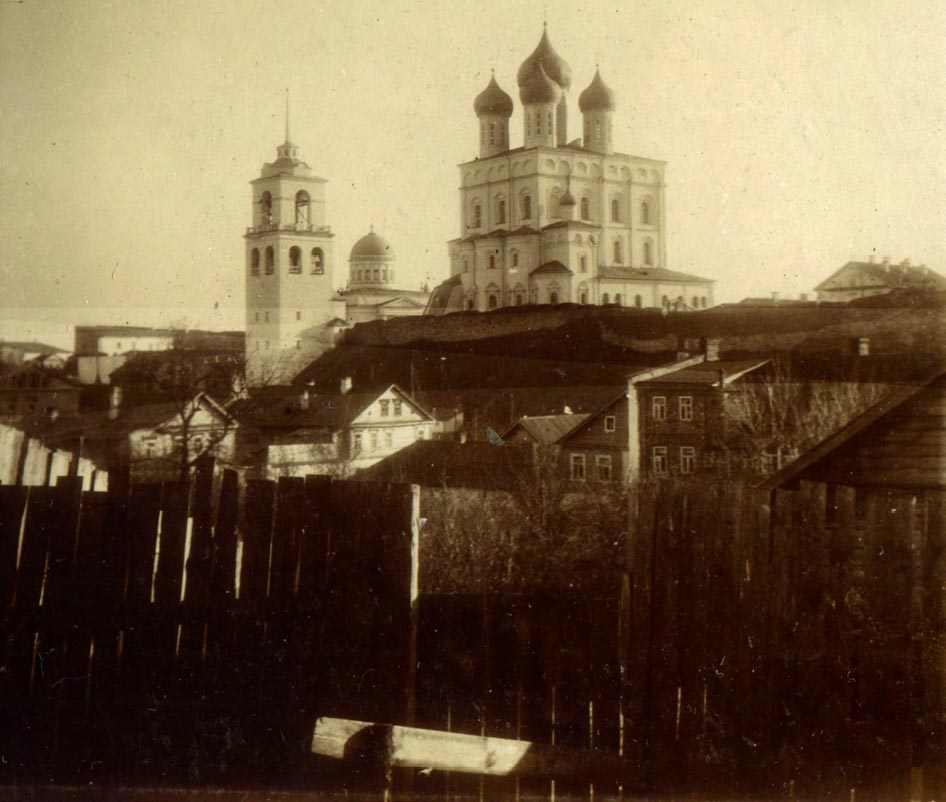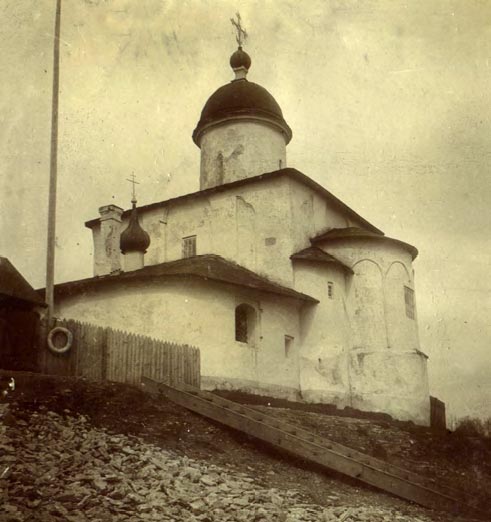SHCHUSEV’S PSKOV EXPEDITIONS
In 1910, upon the recommendation of Igor Emmanuelovich Grabar, the Pskov zemstvo (local elected government) turned to Alexei Viktorovich Shchusev, who was the only person able to manage the difficult undertaking of creating a design for the chapel (St. Anastasia Chapel - S.K.) in the Pskov spirit. And indeed, Shchusev had, by then, earnt a reputation for having a thorough knowledge of the Novgorod and Pskov architecture and for designing several structures inspired by the arresting images and features of this school. The architect, who, at that time, lived and worked in St. Petersburg, regularly travelled to Veliky Novgorod and Pskov to study the architecture. He brought scores of photographs and sketched images of famous paintings and landmark buildings from his trips and he also brought measurements. The depth of his knowledge of the subject is evidenced in the chapters that Shchusev co-wrote with V. Pokrovsky for the first volume of Igor Grabar’s “A History of Russian Art”[1] - “St.Sophia Cathedral of Novgorod and the Beginnings of the Original Architecture”, “The Best Period of Novgorodian Architecture” and “Civil Buildings and Fortifications in Novgorod and Pskov” - and in his array of photographs published in this tome. However, the visits to Veliky Novgorod and Pskov that Shchusev made before the Revolution have been omitted almost entirely from monographs and academic publications about on his work.

A view of the Pskovo-Pechersky Monastery. Alexei Shchusev’s open letter to Maria Shchuseva. April 15, 1906.
Private collection. Published for the first time

A view of Pskov Krom (central part of the old town) from outside of Pskov’s city limits. April 1906.
Photo: Alexei Shchusev. Private collection. Published for the first time
Shchusev’s first recorded expedition to Pskov took place only in April 1906 (the first expedition to Veliky Novgorod was in 1904) - not earlier, as generally assumed. The date of his visit can be inferred from the dates on the sketches, as well as from his correspondence, which includes Shchusev’s postcard to his wife: I made it here only today (Saturday), and will stay here for about 5 days because there are lots of interesting things to see. Write to me at St. Petersburg Inn, Pskov - it's only six hours from St. Petersburg...The weather is fickle, the churches are very interesting, I even want to do some drawing[2].

A view of the Archangel Michael Cathedral in Gorodets. April, 1906.
Photo: Alexei Shchusev. Private collection. Published for the first time

ALEXEI SHCHUSEV. Cupola of the Archangel Michael Cathedral in Gorodets. 1906.
Coal and colour pencils on paper. 31.2 × 23.8 cm.
Private collection. Published for the first time
A unique album full of drawings and photographs survived from the 1906 expedition[3]. They tell us what landmarks Shchusev studied and what he was focused on. The drawings predominantly feature churches and fortifications of Pskov and the Pskovo-Pechersky Monastery, interiors, architectural elements, icons, objects of applied art (door fittings, locks, icon cases, fragments of metal icon covers). Some pieces were produced with lead and coal pencils, with parts of the drawings heightened with wet-on-wet watercolour “alla prima”, and others with coloured pencils. Even working on quick sketches from nature, he achieved striking accuracy in his rendition of objects and the vibrancy and richness of colours. Shchusev’s photographs often show objects from the same angles as they appear in his sketches. Some of the sketches show the influence of the Pskov architectural landscapes by Nicholas Roerich in 1903. According to the recollections of Shchusev’s brother, the architect was particularly impressed by the complex of stone buildings at Pogankiny Palaty and the massive top of the Mirozhsky Monastery cathedral[4], whose contours are evoked in his design sketches for the Trinity Cathedral in Pochaiv and the Pokrovsky Cathedral at the Marfo-Mariinsky Convent.

A view of St. Clement Cathedral in Zavelichie. April, 1906.
Photo: Alexei Shchusev. Private collection. Published for the first time

ALEXEI SHCHUSEV. St. Clement Cathedral in Zavelichie. 1906.
Coal and colour pencils on paper. 23.8 × 31.2 cm.
Private collection. Published for the first time
Although Shchusev travelled to Pskov in 1911 because he was designing the St. Anastasia Chapel, he continued to photograph and sketch the old Russian architectural landmarks during these visits. His last visits to the town took place after the end of the Great Patriotic War (WWII), and his business there was to contribute to the restoration and reconstruction of the destroyed town. The documents and images from the expeditions under review appear have proved very important as they fill in the gaps in our studies of Shchusev. Furthermore, the imagery of Pskov’s landmarks, such as they were in the early 20th century, can be of interest to historians of art and architecture, as well as to art restoration experts.

Sacristy of the Pskovo-Pechersky Monastery. April, 1906.
Photo: Alexei Shchusev. Private collection. Published for the first time

ALEXEI SHCHUSEV. Sacristy of the Pskovo-Pechersky Monastery. 1906.
Coal pencil and watercolour on paper. 31.2 × 23.8 cm.
Private collection. Published for the first time

Views of the (Paromenskaya) Assumption Church in Zavelichie. April, 1906.
Photo: Alexei Shchusev. Private collection. Published for the first time

ALEXEI SHCHUSEV. John the Baptist Cathedral of the Ivanovsky Monastery, portal, window. 1906.
Coal pencil and watercolour on paper. 23.8 × 31.2 cm.
Private collection. Published for the first time
- See Grabar, I.E. “A History of Russian Art”. Vol.1 Moscow. 1910.
- Alexei Shchusev’s open letter to MV. Shchuseva, April 15, 1908 (date indicated on the postage stamp). Private collection. First publication.
- One of the images from the album, a view of the Pskovo-Pechersky Monastery, is in the collection of the Shchusev Museum of Architecture. The sheet bears Shchusev’s signature and the date: 1906.
- Quoted from: P.V. Shchusev, "A Few Chapters from the Life of Academician A.V. Schusev." Moscow. 2011. Pp. 316-344
Lead and grey pencils, watercolour, gouache, bronze paint on paper. 31.2 × 23.8 cm.
Private collection. Published for the first time
Lead and brown pencils, watercolour, gouache, bronze paint on paper. 23.8 × 31.2 cm
Private collection. Published for the first time
Coal and brown pencils, watercolour, gouache on paper. 31.2 × 23.8 cm.
Private collection. Published for the first time
Photo: Alexei Shchusev. Private collection. Published for the first time
Coal and colour pencils on paper. 31.2 × 23.8 cm
Private collection. Published for the first time
Lead and coal pencils and watercolour on paper. 23.8 × 31.2 cm
Private collection. Published for the first time
Lead and grey pencils on paper. 23.8 × 31.2 cm
Private collection. Published for the first time
Coal pencil and watercolour on paper. 31.2 × 23.8 cm
Private collection. Published for the first time
Coal pencil and watercolour on paper. 23.8 × 31.2 cm.
Private collection. Published for the first time
Photo: Alexei Shchusev. Private collection. Published for the first time
Coal pencil and watercolour on paper. 23.8 × 31.2 cm
Private collection. Published for the first time
Coal pencil and watercolour on paper. 31.2 × 23.8 cm
Private collection. Published for the first time
Coal pencil and watercolour on paper. 31.2 × 23.8 cm.
Private collection. Published for the first time
Photo: Alexei Shchusev. Private collection. Published for the first time
Coal pencil and watercolour on paper. 23.8 × 31.2 cm
Private collection. Published for the first time
Coal pencil and watercolour on paper. 23.8 × 31.2 cm.
Private collection. Published for the first time
Coal pencil and watercolour on paper. 23.8 × 31.2 cm.
Private collection. Published for the first time
Photo: Alexei Shchusev. Private collection. Published for the first time
Coal pencil and watercolour on paper. 23.8 × 31.2 cm.
Private collection. Published for the first time
Coal pencil and watercolour on paper. 31.2 × 23.8 cm
Private collection. Published for the first time
Coal pencil and watercolour on paper. 23.8 × 31.2 cm.
Private collection. Published for the first time






























